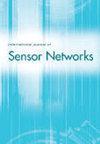无线摄像传感器网络中最小k ω角屏障覆盖
IF 1.1
4区 计算机科学
Q4 COMPUTER SCIENCE, INFORMATION SYSTEMS
引用次数: 6
摘要
障碍物覆盖是无线传感器网络中的一个重要问题,它可以保证检测到任何试图越过障碍物或穿透传感器监控的保护区域的入侵者。然而,无线摄像机传感器网络wcsn中的屏障覆盖问题与标量传感器网络中的屏障覆盖问题不同。本文在k ω角覆盖的基础上,研究了wcsn中最小k ω角屏障覆盖问题。我们首先提出了部署最小数量的相机传感器以形成k ω角屏障的技术。然后提出了一种新的方法,从任意部署中选择最小数量的相机传感器,形成k ω角障壁。通过我们的模拟,我们确认我们的算法与最先进的算法相比减少了所需的传感器数量。本文章由计算机程序翻译,如有差异,请以英文原文为准。
Minimum k, ω-angle barrier coverage in wireless camera sensor networks
Barrier coverage is an important issue in wireless sensor networks, which guarantees to detect any intruder attempting to cross a barrier or penetrating a protected region monitored by sensors. However, the barrier coverage problem in wireless camera sensor networks WCSNs is different from that in scalar sensor networks. In this paper, based on k, ω-angle coverage, we study the minimum k, ω-angle barrier coverage problem in WCSNs. We first present the technique to deploy minimum number of camera sensors to form a k, ω-angle barrier. Then propose a novel method to select the minimum number of camera sensors from an arbitrary deployment to form a k, ω-angle barrier. Though our simulation, we confirm that our algorithms reduce the number of sensors required comparing to the state-of-art algorithm.
求助全文
通过发布文献求助,成功后即可免费获取论文全文。
去求助
来源期刊

International Journal of Sensor Networks
COMPUTER SCIENCE, INFORMATION SYSTEMS-TELECOMMUNICATIONS
CiteScore
2.40
自引率
27.30%
发文量
86
期刊介绍:
IJSNet proposes and fosters discussion on and dissemination of issues related to research and applications of distributed and wireless/wired sensor and actuator networks. Sensor networks is an interdisciplinary field including many fields such as wireless networks and communications, protocols, distributed algorithms, signal processing, embedded systems, and information management.
Topics covered include:
-Energy efficiency, energy efficient protocols-
Applications-
Location techniques, routing, medium access control-
Coverage, connectivity, longevity, scheduling, synchronisation-
Network resource management, network protocols, lightweight protocols-
Fault tolerance/diagnostics-
Foundations-
Data storage, query processing, system architectures, operating systems-
In-network processing and aggregation-
Learning of models from data-
Mobility-
Performance analysis-
Sensor tasking and control-
Security, privacy, data integrity-
Modelling of systems/physical environments, simulation tools/environments.
 求助内容:
求助内容: 应助结果提醒方式:
应助结果提醒方式:


